Catch & Culture Home | Download this issue in PDF
In this issue:
- Editorial
- Fishers agree to help conserve critically-endangered
Mekong giant catfish
- Conservation strategy for giant catfish expected by next year - Tonle Sap dai fishery almost doubles to reach new record
- Status of catfish farming in the delta
- Viet Nam aims to induce spawning of Pangasius krempfi this year
- Cambodia's National Fish Day
- Sharing data and information is just as important as collecting
- New national breeding centre in southern Viet Nam almost complete
- Cambodia and Viet Nam produce first comprehensive books on fishing gear
- Staff movements
- Mekong Fisheries Index
There’s something exciting happening in Chiang Khong in Thailand. Exciting that is for the Mekong giant catfish. The members of the Mekong Giant Catfish Association have agreed to stop catching the endangered fish in and instead to try to help conserve it. The area around Chiang Khong is where the Thai-Lao stretch of the Mekong meets Myanmar, and traditionally the local people have, for one month of the year, tried to catch the giants as they migrate upstream to spawn. No more. The fishers have agreed to stop fishing in return for financial compensation for their nets.
In another more regional initiative, the MRC-affiliated Mekong Wetlands Biodiversity Programme and the British government's Darwin Initiative are taking a new approach to preserving the Mekong Giant Catfish involving national, regional and international partners. Efforts to save the Mekong giant catfish from extinction have, to date, been largely uncoordinated and their effectiveness was unclear. It is hoped this initiative, based on good science and support of all stakeholders, will provide a sound regional strategy.
Still on catfish, but this time of the smaller variety, we take a look at the status of Viet Nam’s thriving aquaculture industry. Our report highlights the need to standardise techniques and calls for stronger comanagement if Viet Nam wants to ensure the sustainability of both the environment and its level of production. We also examine the interesting prospect of introducing a third domesticated species into the aquaculture pool.
The Tonle Sap dai fishery is generally regarded as the most important fishery in the basin and as such has been closely monitored by the Cambodian Department of Fisheries and the MRC Fisheries Programme since the mid 1990s. So it is pleasing to report that last year’s bagnet landings hit a new record, indicating that the fishery is still very productive. It seems human intervention in the form of tougher policing of illegal fishing practices may have been at least partially responsible for the increased catch.
Other features in this issue include a look at two new Khmer and Vietnamese publications on fishing gears, Cambodia’s National Fish Day celebration, the importance of sharing data, news of a new national breeding centre in southern Viet Nam and the latest MRC Fisheries Programme staff changes.
We also have a special four-page colour insert on the Chiang Khong celebration for Mekong giant catfish conservation ceremony. Selected articles from this issue of Catch and Culture will be translated into Khmer, Lao, Thai and Vietnamese. The PDF files can be downloaded from www.mrcmekong.org as can all the features in English.
The Editors
Efforts to stop fishermen setting nets to catch Mekong giant catfish near their spawning grounds in northern Thailand seem to be paying off

Chairman Phoom (left) and Senator Tuenjai display the type of
net
that has been used to catch giant catfish. These gill nets are
usually
3m deep and can be as long as 300m..
Phoom Bunnhak says he was eight or nine years old when he first saw his father catch a Mekong giant catfish (Pangasianodon gigas). "I was very happy," he said, recalling the event more than 40 years ago. "At that time, there was no buying or selling. We had to inform others to prepare buckets to carry the fish which was cut into small pieces to distribute to other villagers." Today, Phoom chairs the 68-member Mekong Giant Catfish Association in Chiang Khong, the centre of a fishing industry in Chiang Rai province in northern Thailand. The Association is now changing its focus from fishing to conservation of the giant catfish.
One of the world's largest freshwater species, the giant catfish can grow to nearly three metres in length and weigh close to 300 kilograms. The fast-growing herbivorous fish mainly eats algae. It was formerly widely distributed throughout the Mekong basin, but now it is extremely rare.
In Chiang Khong, about 100 kilometres south of the Golden Triangle where the Thai-Lao stretch of the Mekong meets Myanmar, the season for catching these giants as they migrate upstream to spawn lasts for barely a month. Opening in mid-April when the river's waters are at their lowest, it continues until the arrival of monsoon rains and the onset of the busy rice planting season in late May or early June. By preserving the flesh of the giant catfish with salt, a prize catch could traditionally provide villagers with a welcome source of additional protein during this slow period following New Year festivities in April. In more recent times, holidays towards the end of the hot dry season have offered students the chance to go fishing for this icon species - success will bring high status to the young fishers.
By the time Phoom went into the business in 1990, the idea of catching giant catfish for local consumption had evolved into a commercial enterprise that coincided with Thailand's emergence as a booming regional economy. With improved cold-storage facilities, it was easier to meet demand from restaurants in big cities across Thailand. Although the Department of Fisheries was already operating a successful breeding program, the demand for giant catfish caught in the wild had skyrocketed in the late eighties.
Official records show that the annual catch in Chiang Khong more than doubled from 24 individuals in 1987 to a record 52 the following year, hitting a new record of 61 in 1989 (see chart on page 7). But after reaching a peak of 65 in 1990 (including 11 caught in Lao waters opposite Chiang Khong), the catch fluctuated for a few years and has been down sharply ever since. From 1994 to 2005, no more than 20 individuals were caught in a single year - and none at all between 2001 and 2003. During this period, the World Conservation Union (IUCN) re-listed the endangered species as "critically endangered", indicating that it faced an "extremely high" risk of extinction in the wild. Despite the alarm bell, villagers stuck to their nets. But catches remained low - seven in 2004 and only four last year including a 2.68 metre beast weighing 285 kilograms, the biggest since detailed records began in 1991.
Efforts to get local fishers to halt their activities came to a head in March during a meeting with Senator Tuenjai Deetes, a prominent social and environment activist in Chiang Rai. According to Phoom, she appealed to the Giant Catfish Association to stop fishing during the 2006 season to mark the 60th anniversary of King Bhumibol's ascension to the throne. "I replied that we'd stop forever if we received compensation," he said.
Under a deal reached on March 29, Phoom explained, Senator Tuenjai and the IUCN are jointly committed to providing each of the 68 members of the association with 20,000 baht ($500) representing the cost of fabricating each of the specially designed large-mesh gill nets. The first payment of 10,000 baht ($250) was scheduled to be made before May, with the second instalment due by October.
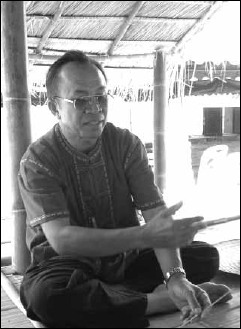
Phoom Bunnhak heads the Giant Catfish Association
in Chiang Khong which now has 68 members.
To avoid being squeezed by middlemen, the association has a monopoly on marketing all giant catfish caught in Chiang Khong and offers guaranteed prices to local fishers. Over the years, Phoom said that these have fluctuated between a low of 100 baht ($2.50) a kilogram and record 300 baht ($7.50). In more recent years, fishers have been receiving between 130 baht ($3.25) and 250 baht ($6.25). Based on the higher recent price, a good-sized catch of a 200-kilogram fish could therefore be worth as much as 50,000 baht ($1,250). Using the same price as a reference, the total compensation of 1.36 million baht ($34,000) for 68 nets is equivalent to 27 giant catfish of identical size. The last time the haul came even remotely close to this was in 1999 when 20 fish were caught in both Thai and Lao waters. Many weighed more than 200 kilograms each.
Hopes for a new beginning
With fishers still waiting to receive their first payment, the annual ceremony marking the start of the giant catfish season this year signalled a positive transition. Although the traditional practice of sacrificing chickens has been abandoned, the local catfish god is still revered in Chiang Khong. A procession by more than a dozen fishing vessels kicked off this year's parade on April 18 and was followed by various dances, including a Chinese-style lion dance featuring a mythical white creature with a goat's head. After a round of speeches by local officials, Senator Tuenjai and Phoom addressed hundreds of villagers and then posed together for photographers holding a symbolic net. The assembled guests then moved to riverbank to release thousands of giant catfish that had been bred in captivity. According to Mr Sanae Polprasithi, a retired fish biologist who pioneered the breeding of giant catfish two decades ago, the annual ceremony is now at a crucial turning point. "This is the first year, the beginning," Sanae told a group of visitors. "We have moved from a hunting ceremony to a conservation ceremony."
But even if the payoffs to fishers are disbursed as planned, there's nothing to guarantee that giant catfish won't be caught in the future in the waters around Chiang Khong. It is possible, for example, that nets with a smaller mesh size designed to catch another big rare fish known simply as the giant catfish (Pangasius sanitwongsei), could accidentally snare the critically-endangered species. "If that happens, the district office says it's okay as long as the size is less than 100 kilograms," the head of the Giant Catfish Association said. The possibility that Thai fishers may violate the ban cannot be ruled out either. Phoom noted that one member was recently expelled for violating rules. As for Lao fishers across the river in Huay Xai, he said their numbers had recently dwindled from about 30 to only four or five. Whether they continue to set nets for the giant catfish or seek similar compensation remains to be seen.
Given that still so little is known about the species, Thailand's Department of Fisheries was taking advantage of this year's migrating season to carry out further genetic research around Chiang Khong. The plan was to collect larvae in two areas near where the giant catfish is believed to spawn and send samples to Japan where Thai and Japanese researchers at Sendai University have developed a genetic marker to separate the giant catfish from other catfish species. Ubolratana Suntornratana, from the Udon Thani Inland Fisheries Research and Development Centre, said none of the 50 samples sent to Japan last year were found to be giant catfish or even from the family of shark catfishes (Pangasidae) to which it belongs. "They were all Siluridae," she said, referring to the sheatfish family. This year, sampling six times every 24 hours was scheduled to start at two sites upstream and downstream from Chiang Khong on April 24 and last until the end of May. "If we're really lucky, we'll get some," Ubolratana said. "But we're not sure."
Catches of giant catfish in Chiang Khong, Thailand, 1983-2005
| Year | Males | Females | Unclear | Total (*) | Fingerlings (**) | ||
| 1983 | 1 | 1 | 2 |
16 |
|||
| 1984 | 9 | 6 | 15 |
130,000 |
|||
| 1985 | 14 | 3 | 17 |
107,000 |
|||
| 1986 | 4 | 1 | 5 |
- |
|||
| 1987 | 22 | 2 | 24 |
10,000 |
|||
| 1988 | 27 | 25 | 52 |
110,000 |
|||
| 1989 | 39 | 22 | 61(1) |
200,000 |
|||
| 1990 | 35 | 30 | 65(11) |
300,000 |
|||
| 1991 | 14 | 19 | 33(8) |
395,000 |
|||
| 1992 | 14 | 8 | 22 |
590,000 |
|||
| 1993 | 27 | 21 | 48(18) |
590,000 |
|||
| 1994 | 10 | 8 | 18(3) |
410,000 |
|||
| 1995 | 10 | 6 | 16(5) |
110,000 |
|||
| 1996 | 5 | 2 | 7 |
- |
|||
| 1997 | 3 | 2 | 5(4) |
50,000 |
|||
| 1998 | 1 | 0 | 1 |
||||
| 1999 | 4 | 11 | 5 | 20(5) |
300,000 |
||
| 2000 | 1 | 1 | 2 |
- |
|||
| 2001 | 0 | 0 | 0 |
- |
|||
| 2002 | 0 | 0 | 0 |
- |
|||
| 2003 | 0 | 0 | 0 |
- |
|||
| 2004 | 4 | 3 | 7 |
74,000 |
|||
| 2005 | 2 | 2 | 4 |
10,364 |
|||
| 246 | 173 | 5 | 424 |
3,319,780 |
|||
* Lao catches in brackets included in total
** Fingerlings produced between 12.5 and 17.5 centimetres
Source: Chiang Rai Inland Fisheries Station
Pangasianodon
gigas |
Pangasius
sanitwongsei |
|||
Family: |
Pangasiidae (shark catfishes) |
Family: |
Pangasiidae (shark catfishes) |
|
English: |
Giant Mekong catfish |
English: |
Giant catfish |
|
Khmer: |
Trey reach |
Khmer: |
Po pruy |
|
Lao: |
Pa beuk |
Lao: |
Pa leum, pa ling |
|
Thai: |
Pla beuk |
Thai: |
Tepa, lerm |
|
Vietnam: |
Ca tra dau |
Vietnam: |
Ca vo co |
|
In the past, efforts to save the Mekong giant catfish from extinction were largely uncoordinated and their effectiveness was unclear. The MRC-affiliated Mekong Wetlands Biodiversity program and the British government's Darwin Initiative are now taking a new approach involving national, regional and international partners.
Recent efforts to save the giant catfish have been coordinated by the Mekong Wetlands Biodiversity Conservation and Sustainable Use Program involving the governments of all four countries in the Lower Mekong Basin. Based in Vientiane, the fiveyear programme started in 2004 and is jointly managed by the United Nations Development Program (UNDP) and the World Conservation Union (IUCN) as well as the MRC. To address the plight of the species, the programme focuses on reducing catches of wild giant catfish and supporting breeding and restocking while identifying and managing critical habitats.
As part of its activities, the Mekong Wetlands Biodiversity programme has teamed up with the Darwin Initiative, a separate programme run by the British Department for Environment, Food and Rural Affairs. Under a two-year grant from the Darwin Initiative starting in 2005, Dr Kai Lorenzen from Imperial College London is working with the Bangkok-based Network of Aquaculture Centres in the Asia-Pacific (NACA) and other partners to develop a long-term conservation strategy for the giant catfish. The Mekong Wetlands and Darwin Initiative projects have established a joint Mekong Giant Catfish Working Group to develop an overarching conservation strategy. The Group brings together all major players in giant catfish conservation, and is coordinated by Dr Naruepon Sukumasavin of the Thai Department of Fisheries.
With the aim of developing a comprehensive strategy by 2007, the Mekong Giant Catfish Working Group held its inception meeting in Bangkok in August last year. The meeting brought together various regional and international partners including the riparian fisheries departments, IUCN, MRC, NACA, Kasetsart University, Imperial College and the Food and Agriculture Organisation of the United Nations (FAO).
In addition to a captive breeding program run by the Thai Department of Fisheries, recent efforts to save the catfish have included buy-back schemes with fishermen, notably in Cambodia (see Catch and Culture, Volume 11, No 2). The Bangkok meeting highlighted the need for more measures - such as modified fishing practices to reduce accidental catches and protected areas to help conserve the species in the wild. Participants also suggested genetic analysis to determine if there are single or multiple stocks, a genetic inventory of captive populations and a gene bank of frozen eggs and sperm.
At the time of the Bangkok meeting, NACA noted that very little was known about the biology of the giant catfish and that even the location of its spawning grounds remained a mystery. "In the past, there has been little coordination between conservation initiatives and consequently their effectiveness is unknown," the regional aquaculture agency said. "The new project aims to change this by bringing together the major players to develop an overarching conservation strategy for the giant catfish."
Participants at the Bangkok meeting agreed to conduct various review and research activities in preparation of the second meeting, which was held in Phnom Penh in December. The group also identified immediate conservation priorities in a Species Conservation Action Plan. The meeting agreed that the overall objective was to maintain a viable wild population, restore the historical distribution of the species, maintain a geneticallyrepresentative captive population and protect critical habitats.
The Mekong Giant Catfish Working Group will continue its work to develop a long-term, overarching conservation strategy for the critically endangered species. The third workshop, to be held in August 2006 in Vientiane, will consider the likely effectiveness of different conservation measures with the help of mathematical models of the giant catfish population. The group aims to finalise its conservation strategy, based on good science and supported by the major stakeholders, in March 2007.
Lieng Sopha, Gregory Cans, Ngor Pengby, Kent G. Hortle
The bagnet, or dai, fishery in the Tonle Sap River has been monitored by the Cambodian Department of Fisheries in conjunction with the MRC Fisheries Programme since the mid 1990s. The fishery targets mainly small-bodied cyprinids when they exit the Great Lake as water levels fall in the latter half of the flood season. The catch is dominated by Trey riel (two Cirrhinus species formerly classified in the Henicorhynchus genus) which account for almost 40% of the total. This is an important fishery, and the annual bagnet landings are assumed to provide an indicator of the health of the fishery resources in the Great Lake-Tonle Sap system.
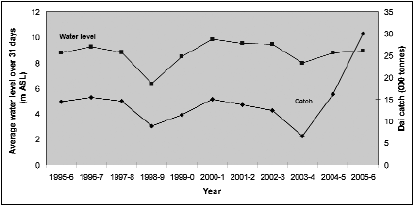 Figure 1. Dai catch and average peak water
level (Phnom Penh Port). The average peak water level is calculated over 31 days, 15 days each side of the peak. |
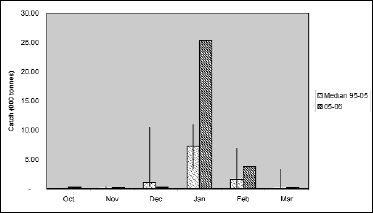
Figure 2. Median dai fishery catch by month 1995-2005 and in the 2005-6 season. Vertical lines indicate the range (max-min) of recorded catches. |
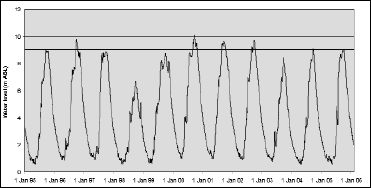 Figure 3. Daily water levels of the Tonle Sap River (Phnom Penh port). The horizontal line is the average peak flood level. |
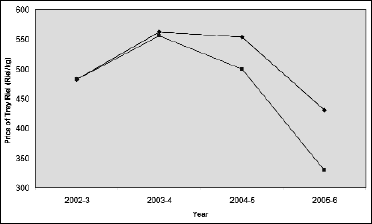
Figure 4. Price of Cirrhinus. The upper line is the actual prices recorded and the lower line is the price adjusted for inflation. |
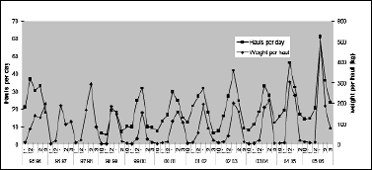
Figure 5. The average weight per haul and the average number of hauls per day 1995-6 to 2005-6 for bagnets on the Tonle Sap River. Note that the time scale has been compressed so that only the sampled months are shown (there is no catch Apr-Sep). Data for hauls per day is not available 1996-7 and 1997-8. |
The fishing season starts in October every year. In 2005, catches in October were slightly higher than normal, but in December the catch fell again to the lowest recorded since systematic sampling of the fishery was started in 1995. Then, in January 2006, the catches surged to the highest monthly catch on record. The combined catch estimate for the year is close to 30,000 tonnes, and the January catch alone, at some 25,000 tonnes, exceeded the total catch in all earlier seasons (Figure 1; Figure 2).
Until the fishing season of 2003-4 the available data show a strong positive correlation between the peak flood water levels and the bagnet landings in the same flood season. The water level of the Tonle Sap River was not particularly high in 2005, although it was marginally higher than in 2004 (Figure 1; Figure 3). Information from flood plain fisheries around the world indicates that high flood levels increases the availability of suitable floodplain habitats, which in turn benefits fish survival and growth (Welcomme and Halls, 2004). While the flood is the main driver of fisheries production, the catch data from the dai fishery (which is based on constant fishing effort) demonstrate that there are factors other than the height of the flood which can also influence production and yield.
As reported by Hortle et al. (2005), the Department of Fisheries carried out a campaign against illegal fishing gears in 2004, including education and enforcement. This was suggested as a possible cause of the relatively high 2004-5 landings. The campaign was continued in 2005, reportedly including confiscation of almost 14,855 fine mesh fyke nets, 11,516 electro fishing gears and 443 km fence nets. In addition, some 120 training events were held, involving 12,000 government staff, police, military, fishers and other stakeholders. The training events were supplemented by the distribution of informational posters and banners. It seems quite possible that the massive effort on enforcement and education over the past two years has contributed markedly to the increase in the bagnet landings.
Another possible contribution to the increase in landings is that large year class of fish from 2004-5, perhaps combined with favourable environmental conditions, enhanced recruitment to the fishery in 2005-6. The bulk of the fish caught in the bagnet fishery are small-bodied and short-lived, so most of the fish caught in the bagnet fishery are spawned at the beginning of the preceding wet season, some 6 months earlier.
Prompted by the dramatic increase in the catch estimate there have been suggestions that the data collected may be biased. However, a closer look at the data does not reveal any inconsistencies. The price of trey riel fell compared to the last few years (Figure 4), consistent with the huge amount of fish that was landed this season. During a few days in mid-January the price was as low as 150 riel per kg. At times during the peak catch the market is saturated and there are no buyers of the fish. The bagnets are then left open to let the fish pass through, so in effect the price approaches zero.
Figure 5 shows the average number of hauls per day and the average weight per haul for the 11 seasons the bagnet fishery has been monitored. As expected, there is a positive correlation between how often the bagnet is lifted and the amount of fish per lift. The high number of hauls and weight per haul last season are both consistent with the high total catch.
The rather gloomy outlook prompted by the low catches in 2003-4 (Hortle et al. 2004) may now be replaced by a more optimistic one. Although the fishing pressure remains high, reductions in use of illegal fishing gears through the enforcement and information campaigns carried out by the Cambodia DoF appears to have led to increased fisheries landings, at least as measured by the landings from the dai fishery in the Tonle Sap River.
Cirrhinus
siamensis |
||
Family: |
Cyprinidae (minnows and carps) |
|
English: |
Siamese mud carp |
|
Khmer: |
Trey riel tob |
|
Lao: |
Pa soi hua lam |
|
Thai: |
Pla soi klorn |
|
Vietnam: |
Ca linh thuy |
|
Cirrhinus
lobatus
|
||
Family: |
Cyprinidae (minnows and carps) |
|
English: |
Siamese mud carp |
|
Khmer: |
Trey riel ongkarm |
|
Lao: |
Pa soi hua pu |
|
Thai: |
Pla soi khao |
|
Vietnam: |
Ca linh onh |
|
References
Hortle Kent G., Ngor Pengbun, Hem Rady and Lieng Sopha (2004). Trends in the Cambodian dai fishery: floods and fishing pressure. Catch and Culture 10 (1): 7-9.
Hortle Kent G., Ngor Pengbun, Hem Rady and Lieng Sopha (2005). Tonle Sap yields record haul. Catch and Culture 11 (1): 3-7.
Welcomme, R and Halls, A (2004). Dependence of tropical river fisheries on flow. In: Proceedings of the Second International Symposium on Management of Large Rivers for Fisheries Volume II. Welcomme, R and T. Petr, Eds., FAO Regional Office for Asia and the Pacific, Bangkok, Thailand. RAP Publication 2004/17, pp. 267-283.
Basa and tra are Viet Nam's key freshwater aquaculture species in terms of domestic income and export revenues - not just for the Mekong Delta but for the country as a whole. Traditional techniques and experiences should be used but need to be standardised and co-management strengthened to ensure the sustainability of both the environment and production.
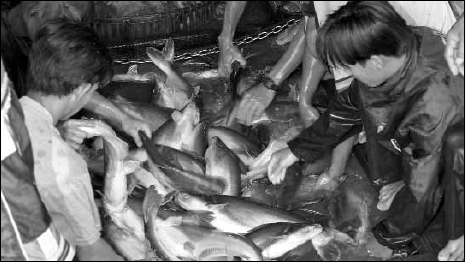
The two species of catfish raised in the
Mekong Delta are omnivorous and grow
quickly in different farming systems. Photo: Joe Garrison
Raising catfish is a traditional activity in the Mekong Delta. Basa and tra are the main freshwater species used in delta aquaculture and have huge potential in terms of biological productivity. A regional network of seed production has boosted household livelihoods and grow-out culture. At the same time, production of the two catfish species has offered significant income opportunities for rural people.
The rapid growth in the catfish industry dates back to 1978 when artificial propagation started in Viet Nam.
Within two decades, production was approaching 50,000 tonnes a year. By the end of the nineties, annual output was still less than 100,000 tonnes. Since then, however, production has skyrocketed to 250,000 tonnes in 2004 and an estimated 400,000 tonnes last year - notwithstanding any adverse impact of anti-dumping duties imposed by the United States in 2003 (see Catch and Culture Volume 9, No. 2).
The two species of catfish are omnivorous and grow quickly in different farming systems as they adapt well to different kinds of feed, usually reaching a kilogram in eight months. In the Mekong Delta provinces of Ang Giang, Can Tho and Dong Thap where 80 percent of the Vietnamese catfish industry is located, survival rates are as high as 70 percent. Land-based ponds can stock up to 80 fish a cubic metre and yield up to 400 tonnes a hectare, while net pens can yield up to 500 tonnes a hectare. River-based cages can stock up to 150 fish a cubic metre, with yields as high as 120 kilograms a cubic meter.
As white-meat fish ranking second only to tilapia worldwide, the two species provide major export opportunities in the area of processed fillets and other value-added products. In 2004 alone, Viet Nam exported 83,000 tonnes of catfish worth more than 200 million dollars with the European Union accounting for 30 percent of the market in terms of value. There is also big potential to expand the local market, especially outside the Mekong Delta.
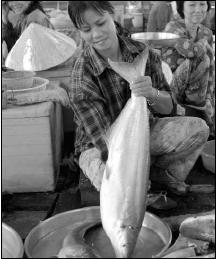
Catfish for sale in the Cau Lanh market
in the Mekong Delta, Viet Nam.
Photo: Joe Garrison
But there are constraints. The industry's development has been explosive without any government guidelines, recommendations or regulations. The resulting rapid increase in production has caused a lot of trouble between producers and traders. The major challenge is the "traceability" of food, feed and ingredients through the production, processing and distribution stages.
About half the industry uses home-made feeds. These vary in quality and composition and may lead to differences in the quality of the fish produced. Consequently, the government is encouraging farmers to use pelleted feeds manufactured commercially. The uncontrolled use of drugs and chemicals to combat outbreaks of disease is another constraint. The goal is to provide farmers with a list of allowed substances.
To avoid overly-rapid development, over-production and pollution, careful planning is need in developing production systems. Zoning areas with licenses for hatcheries, nurseries, ponds, cages and net pens would make tracking and tracing more feasible, as well as reduce pollution.
* Dr. Hao is director of the Research Institute for Aquaculture No. 2 under the Vietnamese Ministry of Fisheries. This article is based on a presentation to the Global Shrimp Conference in Ho Chi Minh City in October last year.
Pangasius
bocourti |
Khmer: |
Trey pra |
|||
Lao: |
Pa suay kheo, pa suay |
||||
Family: |
Pangasiidae (shark catfishes) |
Thai: |
Pla saa whai, pla suey |
||
English: |
Bocourt's catfish |
Vietnam: |
Ca tra song, ca tra |
||
Khmer: |
Trey pra kchau |
||||
Lao: |
Pa nyang, pa phoh hua |
Pangasius
krempfi
|
|||
Thai: |
Pla yang, pla ai dong |
||||
Vietnam: |
Ca basa |
Family: |
Pangasiidae (shark catfishes) |
||
English: |
catfish |
||||
Pangasianodon
hypophthalmus
|
Khmer |
Trey pra bong lao |
|||
Lao: |
Pa suey hang leuang |
||||
Family: |
Pangasiidae (shark catfishes) |
Thai |
Pla suey sor |
||
English: |
Sutchi river catfish |
Vietnam: |
Ca bong lao |
||
Catfish farmers in Viet Nam rely on two Pangasius species. For the past four years, efforts have been underway to domesticate a third.
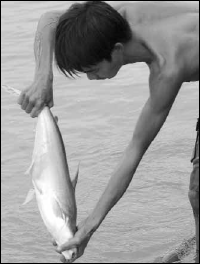
The first step in domesticating P.
krempfi was learning how to capture
and transport them with minimal
mortality.
In 2002, the Aquaculture of Indigenous Mekong Species (AIMS) of the Fisheries Programme decided to target Pangasius krempfi as a potential species for aquaculture. Unlike P. bocourti and P. hypothalmus (see accompanying article on basa and tra), this migrating species had not been domesticated even though the fish is of economic value in the Mekong Delta.
To catch wild specimens of the species, fisheries officers used nets in upstream areas of the Mekong in An Giang province near Cambodia and hooks further downstream in the estuary in Soc Trang province. But by 2004, none of the fish caught and transferred to ponds had survived.
AIMS staff * at the Cai Be station in Tien Giang province have had more success with cage culture since last year. According to a presentation at the Fisheries Program's technical symposium in Ubon Ratchatani in November, the mortality rate of fish caught in 2005 is less than 10 percent (36 fish out of 420). The fish were stocked with Hoeven's slender carp (Leptobarbus hoevenii) in cages in Dong Thap province. After capture, fish of various sizes were kept in temporary holding tanks. Bef
ore being transported, they were anaesthetised and then their pectoral spines were cut (in the case of small fish) or covered by a plastic tube (for larger specimens). The fish were then packed into plastic bags and transferred to a cage, with the plastic tubes removed in the case of the bigger fish.
"This was the first time we were able to keep them alive in a cage," said Trinh Quoc Trong, national director of the AIMS component in Viet Nam. "We're going to try to induce spawning this year if the fish are ready." In addition to spawning, further studies are expected on the biology and behavior of the species (how it is affected by salinity, for example). Nutrition is another area for research on this species, which is believed to spend part of its life in the sea even though it occurs as far north as Chiang Saen where the borders of Lao PDR, Myanmar and Thailand meet.
Apart from domesticating P. krempfi, the other main task of the AIMS component in Viet Nam has been to develop mass seed production for another four species, including the popular Cirrhinus microlepis. Induced spawning of this species has been carried out in Thailand and Lao PDR as well as Viet Nam.
* Trinh Quoc Trong, Huynh Huu Ngai and Thi Thanh Vinh
This important celebration is raising awareness of fisheries in Cambodia

Cambodian Prime Minister Mr Hun Sen told the crowd that the
spirit
of fishery conservation should always be in the hearts of Cambodian
citizens.
Cambodia's National Fish Day on July 1 is shaping up to be the biggest yet with activities planned in several communes in each province this year. At last year's fish release at Beung Sne lake in Prey Veng province, Prime Minister Hun Sen endorsed plans to organise events in communes across the country to raise awareness of fisheries and encourage more local people to take part.
Following a sub-decree by the prime minister in 2002, the first National Fish Day ceremony took place in 2003 with the release of fish into Prek Komppous canal in Kompong Speu province. A second fish release at Punnareay Lake in Kandal province north of Phnom Penh in 2004 drew a huge crowd estimated at 7,000 people.
At the National Fish Day in 2005, Prime Minister Hun Sen noted that "many illegal fishing activities" were still taking place, calling for efforts to halt the use of illegal fishing gear nationwide to prevent resources from being devastated. "The spirit of fishery conservation should always be in the hearts of our citizens," he said.
Cambodian Fisheries Department Deputy Director Sam Nuov said the main commune events associated with inland fisheries in 2006 are likely to involve communes around the Great Lake and those in remote dry areas.
By Wolf Hartmann
A new guide for co-managers and others working in the field
Inefficient flows of information are a major obstacle to managing and developing fisheries successfully. The shift towards co-management has prompted managers to recognise that data collection must now be able to respond to the diverse needs of more than one stakeholder and must be tailored to their objectives and resources.
Over the past year, two separate workshops on data collection and sharing for co-managed fisheries have been held at the Huay Luang Reservoir in northeast Thailand. Participants included 10 communities, four primary schools, and three tambon administration organisations as well as the provincial fisheries office in Udon Thani and the Inland Freshwater Research and Development Center (IFRDC). Provincial environment, tourism and irrigation officials also took part.
Participants pre-tested guidelines jointly drafted by the Marine Resources Assessment Group, the United Nations Food and Agriculture Organization (FAO), the WorldFish Centre, and the MRC under a programme funded by the UK's Department for International Development. Structured around an eight-stage participatory design process, the guidelines aim to complement - rather than replace - the FAO's existing manuals and guides.
Field testing involved communities, tambon officials and government line agencies. The guidelines helped identify common needs among stakeholders such as fisheries production figures, information to determine the best stocking strategies and information about the environment, notably water levels and quality within the reservoir.
The guidelines helped stakeholders agree upon a potential strategy for collecting and sharing data and information. This raised government awareness of the widespread interest among resource users in diversifying livelihoods to include tourism-related activities. Workshop participants agreed to monitor water quality and fish catches on a monthly basis through user representatives from all target communities with technical help from line agencies. The workshop also developed a proposal for data sharing based on capacities and lessons learned by government agencies. This was integrated with the existing tambon system for sharing information as well as communities and schools in the area. After reviewing what data and information already exist, local authorities have agreed to develop a datacollection system and provide financial support.
Based on World FishCenter testing in Bangladesh and MRC testing in Thailand, a practical guide has been written for co-managers and facilitators working in the field. Now available in the Thai and Lao languages, it offers simple and practical advice on identifying different information needs and developing collaborative ways of collecting and sharing the information in the most effective way.
As part of its Fisheries Technical Paper series, the FAO recently published the final version of the guidelines and the field guide incorporating feedback from field testing and evaluation. Free downloadable copies are available from the FAO website.
Further information:
www.fao.org/fi/eims_search/publications_form.asp?lan g=en
An eight-stage participatory process for designing and implementing data collection and sharing systems
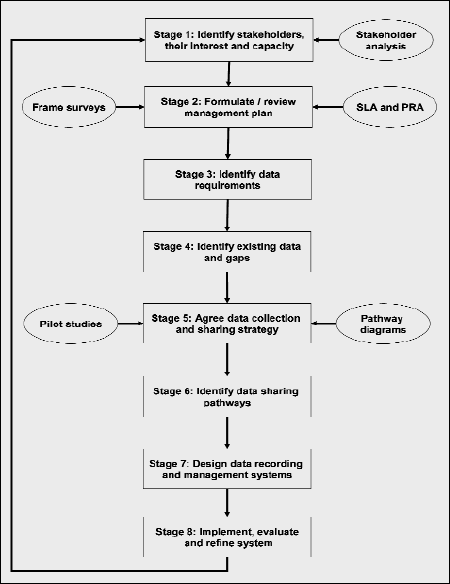
Source: FAO
The government's latest upgrade to a research centre in southern Viet Nam is a big public investment for the aquaculture sector. If things go according to plan, the costs of funding public research into genetic programmes and new technologies will be partly offset by sales of high-quality seed to hatcheries in the south.
TAfter a three-year upgrade costing 34.9 billion dong ($2.2 million), the new National Breeding Centre for Southern Freshwater Aquaculture (Nabrecsofar) in Viet Nam's Tien Giang province is nearing completion. Located on the 19-hectare site of the existing Cai Be station, the newly-renamed research centre is expected to have a production capacity that includes 400 million fry and 40 million fingerlings a year. Viet Nam is reportedly planning to open six breeding centres this year (see Catch and Culture, Volume 11, No. 3).
"We hope everything will be finished in May or June," said Trinh Quoc Trong who is in charge of the genetics and selection division at the Cai Be centre. The other three research divisions are dedicated to seed production and culture techniques, environment and aquatic diseases, and extension and technology transfer. Trong, who is also the National Component Director for the Aquaculture of Indigenous Mekong Fish Species (AIMS) component of the MRC's Fisheries Programme, said each of the four divisions had recruited two new staff since June last year. A fifth division is responsible for administration.
"The bottom line is that we're upgrading to a higher level in terms of capacity and knowledge with better infrastructure and better equipment," Trong said. Under the upgrade started in 2001, the Ministry of Fisheries has invested 25.4 billion dong ($1.6 million) on infrastructure and 5.6 billion dong ($350,000) on new equipment. What the centre lacks in state-of-theart equipment for water quality analyses is available at the ministry's Research Institute for Aquaculture No. 2 in nearby Ho Chi Minh City. As for infrastructure, almost half the site is devoted to ponds. Under a plan formulated in June last year, 42 ponds covering almost 50,000 square metres are designated for nursing and rearing (14 ponds for fingerlings and 28 for fry). Five ponds totalling 10,000 square metres are to be used for broodstock and more than 40,000 square metres have been allocated for six grow-out ponds. The centre also has one indoor hatchery for fish, an outdoor nursery (concrete tanks), one indoor nursery (fibre-glass tanks and aquariums), one hatchery with large fibre-glass tank for holding broodstock, and a hatchery for prawns.
The Ministry of Fisheries acquired the experimental station from the Ministry of Agriculture in 1982. Over the next four years, office, dormitory and warehouse buildings sprung up and a water-supply system was put into place as induced-spawning and seedproduction facilities were developed.
Under a second phase between 1994 and 1997, the ministry invested 1.64 billion dong ($103,000) to upgrade the experimental station to a research centre under the research institute headquartered in Ho Chi Minh City. When Catch and Culture visited the site in February this year, workers were putting the finishing touches to a three-storey main office building (including laboratories, meeting room, library and a museum), as well as two guest houses for visiting experts and trainees.
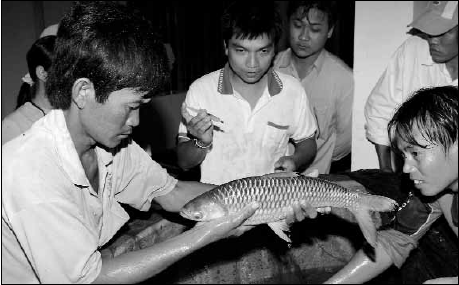
Trinh Quoc Trang prepares to induce spawning in the Leptobarbus
hoevenii at the
Cai Be Aquaculture Centre in the Mekong Delta, Viet Nam. Photo:
Joe Garrison
Like its counterpart in northern Vietnam, Nabrecsofar is not just a research centre but also a business enterprise. Under a plan completed in 2005, its twin mission is to conduct research into genetic conservation, seed production and grow-out of various freshwater species while producing high-quality seed for fish nurseries in the south. Projections for the first year indicate gross expenditure of 3.28 billion dong ($205,000) including 1.42 billion dong ($89,000) for genetic programs and 1.02 billion dong ($64,000) for developing new hatchery and culture technologies. But the funding requirement for the new centre is expected to be partly offset by seed sales of about 600 million dong ($38,000), bringing net expenditure down to about 2.68 billion dong ($167,000).
A recent paper* by the Support for Freshwater Aquaculture (SUFA) project of the Ministry of Fisheries and the Danish aid agency Danida proposes such a model to promote the freshwater seed industry in other developing countries. The authors describe the adoption of business strategies as an "important institutional innovation" for the seed industry. Vietnamese breeding centres may still require external financing from donors, private foundations and industry associations as well as local governments and research grants from the national government. But with seed demand expected to grow at an annual rate of almost five percent between 2005 and 2010, the seed industry is a profitable business in Viet Nam. Moreover, public hatcheries tend to be less subject to genetic deterioration than private hatcheries which have failed to improve genetic quality and promote seed-production technology.
On the other hand, most of the demand in Viet Nam is for mature broodstock. Demand for seed to be ongrown as broodstock is relatively small compared to the production capacity of a typical hatchery - let alone a breeding centre. So, the authors argue, it may not be feasible to run breeding centres entirely as self-sustaining businesses if they are to fulfil their costly social mission of providing high-quality seed from genetically-managed and improved broodstock. But at least the centres should be able to cover some of their costs. "The business model demonstrates a workable strategy to both address seed industry development while reducing recurring cost burdens on the public sector," the authors conclude.
* "The Business Approach to Operating National Broodstock Centres: an Innovative Strategy for Developing the Freshwater Aquaculture Seed Industry in Viet Nam" by a team of consultants led by Roehlano Briones, senior fellow at the Brain Trust Inc., a private think tank in Manila
Catch and Culture doesn't normally do book reviews. But these manuals are so useful and fascinating for specialists and non-specialists alike that we couldn't resist the temptation.
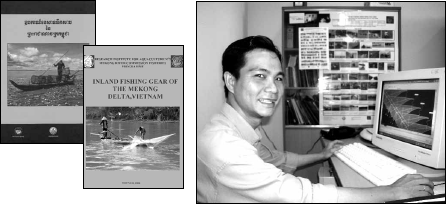
These fishing gear manuals now in Khmer and Vietnamese (English
version cover
above) will benefit national fisheries experts. Right: Mr Nguyen
Nguyen Du of the
Fisheries Ecology, Valuation and Mitigation component, who co-authored
the
Vietnamese publication.
The "Fishing Gears of the Cambodian Mekong" was published in 2003 by the Inland Fisheries Research and Development Institute (IFReDI) of the Cambodian Fisheries Department with the support of the MRC Fisheries Program. This outstanding manual catalogues 150 types of gear in 16 categories. Largely based on field work by provincial fisheries officers, it was compiled by Cambodian biologist Deap Loeung, German socio-economist Peter Degen and Dutch biologist Nicolaas van Zalinge, who previously coordinated the MRC Fisheries Program's Cambodian Capture Fisheries component. Featuring excellent technical drawings and colour photographs, the 269- page hardback edition is an exceptionally high quality the reference book.
The recent completion of a Khmer translation by the Department of Fisheries now makes this important manual available to a wider audience of policymakers, academics, teachers, students and anyone else interested in the industry. In a country where 70 percent of the protein intake comes from fish and where fisheries vies with rice production as the main contributor to economic output, that could mean just about everybody - especially given the book's added appeal to those interested in Cambodian culture and history. As Fisheries Department Director Nao Thuok says in the foreword, "the fabrication and use of each fishing gear reflects the traditional knowledge of generations." As for history, the book recalls that Cambodia was exporting about 50,000 tonnes of fish products a year during the French colonial period, with Chinese traders exporting 25,000 tonnes a year to Indonesia alone.

A vertical cylinder trap for climbing
perch is commonly used in the flood
plains, but also in lakes and quiet
rivers
The Khmer translation - expected to be launched in May following a contribution to printing costs by the Japan International Cooperation Agency (JICA) - contains the same intricate drawings of fishing gear and fascinating illustrations of Cambodians catching fish as the English edition. These are the work of graphic artist Arijan Jansonius, who was also responsible for the original layout. The book also includes the same informative charts showing which months of the year different types of gear are used in four major fishing zones. These are the Tonle Sap Lake (Battambang, Pursat, Siem Reap and Kompong Thom), the Tonle Sap River (Kompong Chhnang, Kandal and Phnom Penh), the Mekong and Bassac floodplains (Takeo, Kandal, Prey Veng and Kompong Cham) and the Upper Mekong and its tributaries (Kratie and Stung Treng).
Not to be outdone, the Ministry of Fisheries across the border in Viet Nam has been hard at work producing its own manual of the different types of gear used in inland fisheries across the Mekong Delta. The 200- page book, the first of its kind in Viet Nam, is also in full colour and is expected to be published in Vietnamese by the Research Institute for Aquaculture No. 2 in Ho Chi Minh City during the second quarter of this year following approval of the final draft in March. The authors are Nguyen Nguyen Du, a biologist with the Assessment of Mekong Capture Fisheries component of the MRC Fisheries Program, and national component officer Nguyen Phuoc Thuong along with Claire Smallwood, an Australian youth ambassador who was attached to RIA2.
The Vietnamese manual documents 120 types of gear. These are classified into 10 categories - gillnets, bag nets, cone-shaped nets, lift nets, hooks and lines, collection methods, scoop nets, small traps, big traps and miscellaneous gear such as spears and electrical equipment. The book includes explanations of how different types of fishing gear are operated as well as catch rates and species caught - which vary significantly . depending on which categories and types are used.
The project to develop the book started in late 2004 and lasted nine months, with Mr. Du spending two weeks out in the field in each of the 13 provinces covered. "It was tough work and it rained a lot," he said. The biologist interviewed fishermen about the construction, cost, operation and catch of different types of gear and also asked them about their backgrounds, historical catch data and knowledge of Vietnamese fishing regulations.
Like the Cambodian manual, the book contains drawings with measurements and photographs of the various types of gear used. Non-speakers of the language shouldn't be deterred by the book's Vietnamese title ("Ngu cu Khai thac Thuy san Noi dia Dong bang Song Cuu Long" which roughly translates as "Inland Fishing Gear of the Mekong Delta"). The manual not only includes an English translation of the abstract, but all categories and types of gear are listed in both languages with convenient page references for the adventurous reader. An English translation is expected to be completed in late 2006.
Incoming

Garry Bernacsek
Dr Garry Bernacsek has been appointed as component coordinator for the Fisheries Programme's Fisheries Ecology, Valuation and Mitigation component starting in May. He will be based at the Inland Fisheries Research and Development Institute (IFReDI) in Phnom Penh.
Gary has dual citizenship of Australia and Canada, completing his undergraduate studies in Canada and his PhD at the University of Bristol in Britain. For the past 25 years, he has worked as a fisheries and environmental consultant in numerous countries, primarily in Africa and Asia. Gary is known to some of us already, as he has undertaken several assignments in Viet Nam and Cambodia. He also worked for the Fisheries Programme as a consultant in 1996-98, producing the database on fisheries in reservoirs in the Lower Mekong Basin. Garry has been employed by many agencies such as FAO, ADB, the World Bank and bilateral donors, as well as national governments and the private sector. His expertise covers both aquaculture and capture fisheries.
We welcome Garry to the MRC Fisheries Programme. His experience and enthusiasm will be of great benefit to the programme and to the fisheries agencies in member countries.
Outgoing

Niklas Mattson
Dr Niklas Mattson has been appointed as a fisheries advisor to FAO in Bangkok, where he will be working with post-tsunami rehabilitation and reconstruction projects in Thailand and nearby countries.
Niklas joined the MRC Fisheries Programme in February 1998. He was originally assigned as a fisheries biologist to the Management of Reservoir Fisheries component, focusing on Lao PDR and northeast Thailand. Later, he assisted the Assessment of Mekong Capture Fisheries component with many fisheries surveys throughout the basin. With experience in both capture fisheries and aquaculture, he was appointed as the Component Coordinator for the Aquaculture of Indigenous Mekong Fish Species (AIMS) project in 2001. In this role, Niklas worked across all MRC countries, becoming a good friend and valuable colleague to all in AIMS.
Niklas will still be working in the region, so we hope to see him from time to time, especially at our annual Technical Symposium. We wish him and his family every success in the future.
Raft-caged fish die en masse in southern
Vietnam
Thanh Nien News, 3 January 2006
Overcrowding, pollution, or cold weather may have been the trigger
that killed thousands of catfish raised in pens in the Mekong
River Delta in recent days. Southern An Giang province, a leading
fish exporter in the country suffered the worst damage. Hundreds
of families in the capital city suffered, with many pens seeing
entire fish stocks die. Nguyen Huu Khanh, president of the province's
Fish Association attributed the incident to a combination of
overstocked pens, cold weather and water pollution. He said
that some farmers, eager for profit to offset recent losses,
raise fish in high density, which invites pathological germs
and disease. Nguyen Thi Ngoc Ha, head of the fish promotion
section under An Giang Center for Aquaculture Research and Production
concurred.
She warned farmers not to raise more than 100 fish for every cubic metre of water. Parasites clinging to fish's gills could stifle and kill them, she explained. In order to cope with the problem, Ha recommends rinsing affected fish in chemicals to rid them of parasites. She also cautions strongly against the use of antibiotics.Other preventative measures include ventilation, diet, and the use of medicinal herbs.
Seasonal Smell of Prahok draws various
reactions
Cambodia Daily, 3 January 2006
Tourists visiting the floating village of Chong Khneas on Tonle
Sap Lake often find the pervading smell of the seasonal prahok
making activities a bit of a shock. The solution appears to
be to move the tourist boat dock away from the fishing harbour.
In September the Asian Development Bank completed a study for
the development of fishing and tourist harbours, a 5km channel
in the lake and a new road to Siem Reap town. When the relocation
is complete Chong Khneas will now be promoted as a tourist site
to relax and enjoy the floating village among the flooded forest.
Sustaining Livelihoods on Cambodia's
Tonle Sap
Asian Development Bank News Release, January
3 2006
A US$15 million ADB grant will help improve livelihoods and
reduce poverty in the five provinces that adjoin the Tonle Sap
Lake in Cambodia, according to an ADB press release. The project
will help increase access to assets by establishing a livelihood
fund to finance small-scale communitydriven activities relating
to social infrastructure, income-generation, and community fisheries.
It will help form special interest groups, assist organisations
in formulating proposals for funding, and familiarise government
institutions at the central, provincial, and commune levels
with the livelihood fund. The project covers 37 communes surrounding
the lake. At the same time, the project will ensure that the
Tonle Sap's core areas are protected by establishing a management
system that is compatible with biodiversity conservation. The
project is part of ADB's Tonle Sap Initiative, a partnership
of organisations and people working to meet the poverty and
environment challenges of the Tonle Sap. ADB's grant, which
covers 74% of the project's total estimated cost of $20.3 million,
comes from its Asian Development Fund. The Government of Finland
will provide a $4.7 million grant, and the Government of Cambodia
will shoulder the balance of $600,000. The Ministry of Interior
is the executing agency for the project, which is due for completion
in December 2009.
Giant Catfish Spared From Fishing on
Cambodia River
National Geographic News 10 January 2006
On Cambodia's Tonle Sap River, conservationist Zeb Hogan is
hoping to save the giant catfish, the largest freshwater fish
in the world, one fish at a time. If fishers here catch the
critically endangered species, which can grow up to 3 metres
long and weigh 295kg, they now must turn it over to Hogan, who
heads the Mekong Fish Conservation Project. Hogan's team then
tags and releases the fish back in the river. In the past, Hogan
has paid market price for any endangered fish, including giant
catfish, caught by the fishers who operate nets on the Tonle
Sap. But the Cambodian Department of Fisheries recently declared
the row of nets, the largest commercial fishing operation on
the river, a special research and conservation area. "What that
means is that the fishermen are obligated to provide endangered
species that they catch to us free of charge for tagging and
release," said Hogan, a biologist affiliated with the University
of Wisconsin-Madison. In the last century, the Giant Catfish
population has declined 95 to 99 percent. Hogan says there may
only be a few hundred adult giant catfish left in the system
today.
Wildlife experts: Cambodia's freshwater
dolphins face extinction
www.chinaview.cn,
10 January 2006
Wildlife preservation officials are worried that Cambodia's
rare freshwater dolphin species will be extinct in the next
10 years, according to reports in local newspapers. Most of
the dolphins are dying in fishing nets, The Cambodia Press Review
quoted Phy Somany, senior officer of the Mekong Dolphin Conservation
Project, as saying that studies estimated that about 10 dolphin
calves are born each year, but Fisheries Department data shows
that 14 died in 2003, 18 in 2004 and 13 in 2005. One dolphin
has already died in the first week and a half of 2006, Jian
Hua Daily reported. An official of the Economic, Social
and Cultural Observer Unit at the Council of Ministers said
local organisations must launch an educational programme for
fishermen to help prevent the dolphins from being caught and
dying in nets. Otherwise the current mortality rate means the
Mekong River dolphins will be extinct in 10 years. The estimated
70 to 100 freshwater dolphins spend the dry season in nine locations
along the Mekong River in Stung Treng and Kratie provinces.
Tourism Ministry Secretary of State Thong Khon said the ministry
had begun patrols along the river and was investigating the
reasons behind the deaths of the dolphins to prevent their extinction.
Villagers may be relocated from dolphin habitats or encouraged
to engage in fish-farming ventures.
Fish, chips, please, but what is on
the plate?
Adelaide Advertiser, 14 January 2006
Butterfish - South Australia's favourite from fish and chip
shops - is largely cheap imported species including a Vietnamese
catfish banned in three US states because it contained chemical
residues. Butterfish, thought by many South Australians to be
locally caught mulloway, flake or even a defined species of
the same name, in fact is virtually always an ocean fish called
hake, caught and processed on giant floating factory ships in
South Africa. Other fish to fill butterfish orders include hoki
from New Zealand, while fishing industry experts warn a new
Vietnamese import is becoming more common in hotels and budget
and fast food outlets. The Vietnamese import, sold thawed in
supermarkets and some fishmongers as cheap white fish fillets
under the generic name “basa” is, in fact, a Mekong River catfish.
Basa has come into the marketplace as smaller portioned hake
fillets decrease in quantity from overfishing. The basa fish
has been banned in three US states because of the presence of
antibiotics found in food safety tests. Samples imported into
Australia have been found to contain low-level residues of synthetic
dyes, but health authorities have assessed the levels too low
to pose a health risk.
HCM City opts for aquaculture, animal
husbandry over crops
VietNam News, 4 February, 2006
Farmers in Ho Chi Minh City are rapidly switching to aquaculture
and animal husbandry while agricultural workers are moving into
the industrial and service sectors to increase their income.
The director of HCM City's Department of Agriculture and Rural
Development said that the share of aquaculture in agricultural
output had almost doubled since 2001 from 18.9% to 30.5%. The
high incomes to be earned from shrimp breeding have seen large
areas of low yielding rice paddy in the city's outlying districts
switch to aquaculture.
Approval given for huge freshwater aquarium
in Nong Khai
Bangkok Post, 13 February 2006
A project to build one of the region's biggest freshwater aquariums
in Nong Khai, Thailand has been approved, with Khon Kaen University
entrusted with taking charge of the project and running the
facility. The university has also allowed its Nong Khai campus
to be used as the site for the aquarium's construction. The
361-million-baht aquarium, which will become one of the largest
in the region, will initially be used for research and study.
The aquarium will also serve as conservation sanctuary for marine
species exclusively found in the Mekong River. The province
has already allocated a budget of 8.06 million baht for the
construction of a nursing pond for fish spawn, which will form
part of the aquarium project. The nursing pond is expected to
be finished by March.
Two more baby dolphins die in Mekong
River
Associated Press, 15 February 2006
Two more Irrawaddy dolphins have died in Cambodia's stretch
of the Mekong River, raising concerns about the survival of
the species, officials said. The two calves, aged between four
weeks and two months, were discovered floating in the river,
said Lor Bun San of the Cambodian Mekong Dolphin Conservation
Project. The cause of their deaths was not immediately known,
but officials have said that environmental pollution and illegal
fishing nets were probably behind the recent deaths of at least
eight other Irrawaddy dolphins in Cambodia's portion of the
Mekong. The Worldwide Fund for Nature (WWF) has called the deaths
a “serious situation” that threatens the future of the animals.
It was estimated earlier this month that only 80 to 100 Irrawaddy
dolphins are left in the Mekong River. Sam Kim Lorn, chief fisheries
officer in Kratie province, said illegal fishing nets were the
cause of most dolphin deaths and that authorities were conducting
day-and-night patrols of the river to crack down on the problem.
US imposes higher tariffs on catfish
VietNam News,18 March 2006
Higher anti-dumping tariffs have been slapped on catfish fillet
imports from Viet Nam based on a review of the US Department
of Commerce, hurting Vietnamese basa and tra fish farmers. The
review released earlier this week cut the number of basa and
tra fillet exporters subject to the reduced tariff rates ranging
from 36.84% top 53.68% from 11 to 2. The tariff for most catfish
exports was kept unchanged at 63.68%.
Prices soar, shrimp die, plants thirsty
for materials
VietNam Net, 2 April 2006 The 2006
shrimp culture crop has not been as successful as expected.
Shrimp are dying en masse in the Mekong River Delta. In Tra
Vinh Province, more than 70 million shrimp have died. Meanwhile,
Ca Mau Province has reported 20-80% losses in its hundreds of
thousands of hectares of shrimp breeding area. Kien Giang has
also reported severe losses of 20- 80% in some areas. Shrimp
material prices have skyrocketed to VND160,000 per kilo ($10)
due to the supply shortage. The lack of material is forecast
to last until mid May or June, when the southern area is due
to harvest a new crop. The shrimp deaths have made seafood processors
worry about how to fulfil export orders. Tra and basa prices
have also skyrocketed recently. Processing enterprises are offering
high prices, VND13,000 per kilo of tra and VND15,000 per kilo
of basa. Meanwhile, farmers do not want to make transactions
now; they want to wait for the prices to go up further. As a
result, processing plants are running at just 50% of their designed
capacity. The output of tra in some provincial communes is down
by 30% compared to 2005 as many farmers have decided to give
up fish farming.
VN struggles with chemicals in shrimp
VietNam Net, 4 April 2006
Deputy Minister of Fisheries Nguyen Thi Hong Minh has called
on the shrimp industry to take drastic measures to stop the
introduction of contaminants into shrimp before Viet Nam's seafood
industry loses its customers. To date Ca Mau province police
have discovered 255 cases of prohibited chemicals in shrimp,
seizing 66 tonnes of materials. The two most serious cases have
gone to court, resulting in jail sentences. Now, in accordance
with a plan signed by Minister of Fisheries Ta Quang Ngoc on
March 22, the ministry will examine 100% of raw shrimp brought
to the processors or to collecting agents in the Mekong River
Delta. In addition authorities will set up a market specifically
for monitoring quality in Ca Mau province.
New funding helps Mekong River Commission
meet basin challenges
Mekong River Commission press release, 4 April 2006
The donor community had continued to show strong support for
the work of the Mekong River Commission over the past six months
with several new agreements being signed to stimulate new programme
work H.E. Mr Sithaheng Rasphone, Chairman of the Mekong River
Commission (MRC) Joint Committee for 2005/2006 told delegates
at an MRC Joint Committee meeting held in Savannakhet, Lao PDR.He
said that this continuous support was a positive encouragement
to the MRC and would help it fulfil the goals set out in the
1995 Agreement on Cooperation for Sustainable Development of
the Mekong River Basin, the agreement which founded the MRC.
He added that over the past year MRC's relationship with China
and Myanmar had strengthened and MRC was now poised to move
toward more concrete technical cooperation within its established
dialogue partnership and was in the process of discussing and
identifying a number of possible work areas. MRC Secretariat
Chief Executive Officer Dr Olivier Cogels added his thanks to
the donor community for their support and told delegates that
new funding agreements worth more than US$8.3 million had been
signed with Australia, Belgium, the Challenge Programme on Water
and Food, Denmark, Finland, France, Japan, Sweden and the United
States of America during the past six months. The Belgian funding
had enabled the launching of the Navigation Programme, while
Denmark had provided the bulk of funding needed to support the
Fisheries Programme for a further three years.
New species of freshwater stingray discovered
in Thailand
Bangkok Post, 13 April 2006
A new species of freshwater stingray has been discovered in
a river in western Thailand, but its chances for long-term survival
are slim, warns WWF. The new species of stingray, measuring
60cm in width, was first observed two years ago, but has only
now been confirmed in detail as a new species by researchers
from WWF Thailand and the US-based Smithsonian Institute. WWF
Thailand's Senior Freshwater Biologist, Dr Chavalit Vidthayanon,
along with Smithsonian Research Associate Dr Tyson Roberts,
have described in detail the new freshwater stingray, known
as Himantura kittipongi, found in the
Maeklong Basin of western Thailand.Thai rivers have been plagued
by serious pollution, overfishing and dam building, which have
taken a deadly toll on Thailand's once diverse and abundant
river life. The ray is believed to exist in only small numbers.
The new species was named Himantura kittipongi after prominent
Thai fish expert Kittipong Jaruthanin who first observed the
ray in 2004.
Historic End to the Fishing of Mekong
Giant Catfish in Thailand
Mekong Wetlands Biodiversity Programme press Release April
2006
An agreement has been signed in Thailand to cease fishing of
the Mekong Giant Catfish, Pangasianodon gigas, from this year
onwards. The agreement was made at a milestone meeting in Chiang
Khong on 29 March 2006, and signed by the Department of Fisheries,
the Senator of Chiang Rai, the Mekong Giant Catfish Club (MGC
Club), Mekong Wetlands Biodiversity Conservation and Sustainable
Use Programme (MWBP), Chiang Khong Head of District and Wildlife
Fund Thailand. The meeting, organised and facilitated by the
MWBP, provided a platform to continue dialogue and develop possible
solutions on Giant Catfish issues and wider aquatic biodiversity
conservation issues in Chiang Khong. Commitment to abide by
the decision was provided by the MGC Club, if members were compensated
on their investment for nets. In response to this request, conservation
organisations and government departments committed to raise
funds for compensation. The Mekong giant catfish is a Mekong
endemic and candidate for the world's largest freshwater fish.
In 2003 it was listed as Critically Endangered by the World
Conservation Union (IUCN). The MWBP identified the fish as a
flagship species to address wider aquatic biodiversity conservation
issues in the Mekong River, and is now a partner in the Mekong
Group contributing to the development of a conservation strategy
for the giant catfish. Another outcome of the successful meeting
was the agreement of community members and the MGC Club to designate
a fish conservation zone along the Mekong River adjacent to
Had Krai village. This deep pool is known to be an important
area for dry season fish refuge and possible spawning area of
selected fish species. There will be no fishing permitted in
this area. The official declaration of this fish conservation
zone was made during the Giant Catfish Festival in Chiang Khong
on 17-19 April 2006.
Choose a newsletter:
 Top
Top